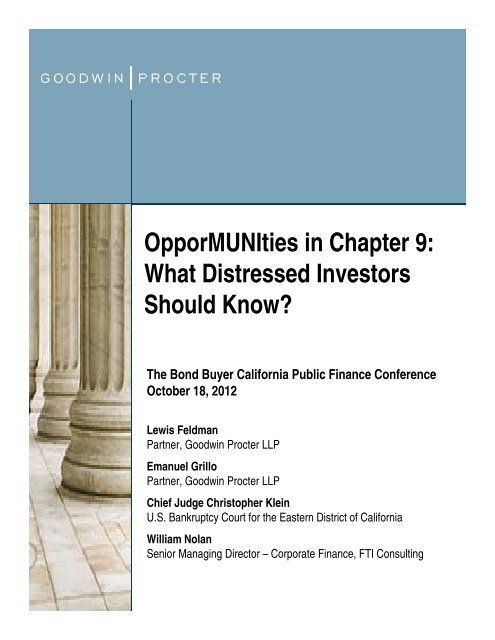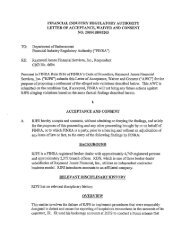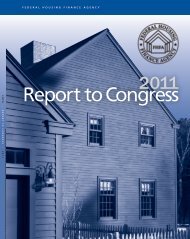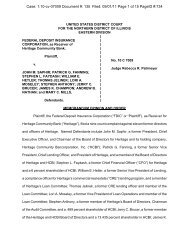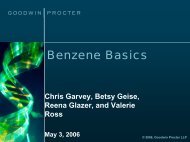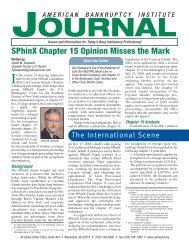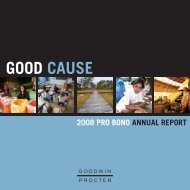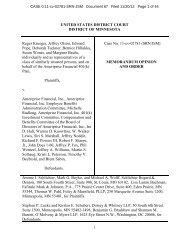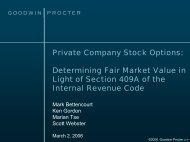Here - Goodwin Procter LLP
Here - Goodwin Procter LLP
Here - Goodwin Procter LLP
Create successful ePaper yourself
Turn your PDF publications into a flip-book with our unique Google optimized e-Paper software.
OpporMUNIties in Chapter 9:<br />
What Distressed Investors<br />
Should Know?<br />
The Bond Buyer California Public Finance Conference<br />
October 18, 2012<br />
Lewis Feldman<br />
Partner, <strong>Goodwin</strong> <strong>Procter</strong> <strong>LLP</strong><br />
Emanuel Grillo<br />
Partner, <strong>Goodwin</strong> <strong>Procter</strong> <strong>LLP</strong><br />
Chief Judge Christopher Klein<br />
U.S. Bankruptcy Court for the Eastern District of California<br />
William Nolan<br />
Senior Managing Director – Corporate Finance, FTI Consulting
Municipal Bankruptcies: Chapter 9 Filings<br />
Cities, towns and counties are shown in red. Utility authorities and other municipalities are displayed in black.<br />
WASHINGTON<br />
OREGON<br />
$<br />
$<br />
MONTANA<br />
NORTH<br />
DAKOTA<br />
SOUTH<br />
DAKOTA<br />
MINNESOTA<br />
WISCONSIN<br />
NEW HAMPSHIRE<br />
VERMONT<br />
MAINE<br />
IDAHO<br />
WYOMING<br />
NEBRASKA<br />
$<br />
IOWA<br />
MICHIGAN<br />
NEW YORK<br />
$ $ $<br />
$<br />
$<br />
$<br />
NEVADA<br />
UTAH<br />
COLORADO<br />
KANSAS<br />
$<br />
ILLINOIS INDIANA OHIO<br />
WEST<br />
VIRGINIA<br />
PENNSYLVANIA<br />
NEW JERSEY<br />
DELAWARE<br />
MASSACHUSETTS<br />
RHODE ISLAND<br />
CONNECTICUT<br />
CALIFORNIA<br />
$<br />
ARIZONA<br />
NEW MEXICO<br />
OKLAHOMA<br />
IOWA<br />
$ $ $<br />
ARKANSAS<br />
KENTUCKY<br />
TENNESSEE<br />
$<br />
$<br />
GEORGIA<br />
$ $<br />
SOUTH<br />
CAROLINA<br />
VIRGINIA<br />
NORTH<br />
CAROLINA<br />
MARYLAND<br />
DISTRICT OF<br />
COLUMBIA<br />
TEXAS<br />
$<br />
MISSISSIPPI<br />
ALABAMA<br />
$<br />
LOUISIANA<br />
FLORIDA<br />
Source: Governing. This map shows all municipalities filing for Chapter 9 bankruptcy protection since 2010, along with local governments voting to approve a bankruptcy filing. Information current as of September 11, 2012.
MUNICIPAL BANKRUPTCIES:<br />
CHAPTER 9 FILINGS<br />
Cities, towns and counties are shown in red. Utility authorities and other municipalities are displayed<br />
in black.<br />
Source: Governing. This map shows all municipalities filing for Chapter 9 bankruptcy protection since 2010, along with local governments voting to approve a bankruptcy filing.<br />
Information current as of September 11, 2012.<br />
Legend:<br />
Alabama<br />
Jefferson County<br />
Status: Filed for bankruptcy<br />
Date: 11/9/2011<br />
Debt or Deficit Amount: More than $4 billion<br />
The county has laid off about 500 workers since declaring for<br />
bankruptcy in November 2011. A federal judge ruled in March<br />
that the bankruptcy was allowed under state law.<br />
Arkansas<br />
Centerton Municpal Property Owners’ Improvement<br />
District No. 3 – Versailles<br />
Fayetteville, AR<br />
Status: Filed for bankruptcy<br />
Date: 10/12/2011<br />
Sylamore Valley Water Association Public Facilities Board<br />
of Izard County<br />
Mountain View, AR<br />
Status: Filed for bankruptcy<br />
Date: 4/19/2012<br />
California<br />
Mendocino Cost Recreation and Park District<br />
Fort Bragg, CA<br />
Status: Filed for Bankrupcy<br />
Date: 12/29/2011<br />
Stockton<br />
Status: Filed for bankruptcy<br />
Date: 6/28/2012<br />
Debt or Deficit Amount: $26 million<br />
Stockton, Calif., filed for bankruptcy after being unable to reach<br />
an agreement with its creditors. The city must pay steep<br />
pension and payroll costs while taking in less money from<br />
property taxes.<br />
Mammoth Lakes<br />
Status: Filed for bankruptcy<br />
Date: 7/3/2012<br />
Debt or Deficit Amount: $43 million<br />
Mammoth Lakes, a small California resort town, voted to file for<br />
bankruptcy July 3. The city has been unable to pay a $43 million<br />
legal judgment resulting from a 1997 property development<br />
dispute.
MUNICIPAL BANKRUPTCIES: CHAPTER 9 FILINGS<br />
California (cont.)<br />
San Bernardino<br />
Status: Filed for bankruptcy<br />
Date: 8/1/2012<br />
Debt or Deficit Amount: $46 million<br />
San Bernardino City Council voted to file for bankruptcy<br />
protection after learning the city had only $150,000 left in its<br />
bank accounts.<br />
Georgia<br />
Hospital Authority of Charlton County<br />
Folkston, GA<br />
Status: Filed for bankruptcy<br />
Date: 4/30/2012<br />
Idaho<br />
Boise County<br />
Status: Bankruptcy filing rejected<br />
Date: 9/8/2011<br />
Debt or Deficit Amount: $5.4 million<br />
A federal judgment ordered the rural county to pay $5.4 million<br />
in damages and attorney fees to developer Oaas-Laney for<br />
allegedly violating the federal Fair Housing Act. The county<br />
later filed for bankruptcy, but failed to prove it was insolvent.<br />
Lost Rivers District Hospital<br />
Arco, ID<br />
Status: Filed for bankruptcy<br />
Date: 3/10/2010<br />
Missouri<br />
Lake Lotawana Community Improvement District<br />
Lee's Summit, MO<br />
Status: Filed for bankruptcy<br />
Date: 8/27/2010<br />
Nebraska<br />
Sanitary and Improvement District #512 of Douglas<br />
County<br />
Omaha, NE<br />
Status: Filed for bankruptcy<br />
Date: 11/1/2011<br />
New York<br />
Suffolk Regional Off-Track Betting Corporation<br />
Hauppauge, NY<br />
Status: Filed for bankruptcy after initial filing in 2011 was<br />
rejected<br />
Date: 5/11/2012<br />
The New York State Legislature changed the state's laws to<br />
allow Suffolk OTB to file for bankruptcy after the agency's<br />
previous filing was rejected. Suffolk OTB, which manges six<br />
branches, reported a $5.1 million net operating loss for 2011.<br />
Oklahoma<br />
Rural Water District No. 1, Cherokee County<br />
Ft. Gibson, OK<br />
Status: Filed for bankruptcy<br />
Date: 1/23/2012<br />
Pennsylvania<br />
Harrisburg<br />
Status: Bankruptcy filing rejected, defaulted on payments<br />
Date: 3/10/2012<br />
Debt or Deficit Amount: More than $300 million<br />
Harrisburg skipped about $5 million in debt payments in<br />
March. Much of the city's debt is related to a failed waste-toenergy<br />
plant.<br />
Rhode Island<br />
Central Falls<br />
Status: Filed for bankruptcy<br />
Date: 8/1/2011<br />
Debt or Deficit Amount: $21 million of outstanding debt, plus<br />
unfunded pension liabilities<br />
State-appointed receiver Robert Flanders filed for bankruptcy<br />
protection and has since cut pensions for retirees.<br />
South Carolina<br />
Barnwell County Hospital<br />
Barnwell, SC<br />
Status: Filed for bankruptcy<br />
Date: 10/5/2011<br />
Bamberg County Memorial Hospital<br />
Bamberg, SC<br />
Status: Filed for bankruptcy<br />
Date: 6/20/2011<br />
<strong>Goodwin</strong> <strong>Procter</strong>, <strong>LLP</strong>
MUNICIPAL MARKET: ISSUER CONCENTRATION<br />
FIVE STATES DOMINATE THE $3.7 TRILLION MUNICIPAL BOND MARKET<br />
Of the $3.71 trillion in total outstanding debt sold, the top 10 states and their municipalities account for $2.15 trillion, or 58%. The top five states alone –<br />
California, New York, Texas, Illinois and Florida, account for almost 46 % of the entire market.<br />
SOURCE: Bloomberg Visual Guide to Municipal Bonds, “Bloomberg Brief: Municipal Market” (June 21, 2011)<br />
Amount Outstanding<br />
Investors<br />
State<br />
($ Billions)<br />
California 585.7<br />
New York 373.6<br />
Texas 320.0<br />
Illinois 190.8<br />
Florida 182.5<br />
Pennsylvania 148.4<br />
New Jersey 135.5<br />
Ohio 113.4<br />
Massachusetts 107.1<br />
Puerto Rico 105.1<br />
Michigan 88.7<br />
Washington 83.9<br />
Georgia 79.1<br />
Colorado 69.9<br />
Virginia 66.5<br />
Arizona 61.7<br />
Indiana 61.1<br />
North Carolina 60.3<br />
Missouri 58.9<br />
Minnesota 55.8<br />
Tennessee 50.5<br />
Maryland 50.3<br />
Connecticut 47.8<br />
Wisconsin 47.3<br />
South Carolina 40.9<br />
Kentucky 38.5<br />
Louisiana 38.3<br />
Amount Outstanding<br />
Investors<br />
State<br />
($ Billions)<br />
Oregon 37.4<br />
Alabama 36.5<br />
Nevada 33.4<br />
DC 30.5<br />
Mississippi 26.1<br />
Utah 24.8<br />
Kansas 24.2<br />
Iowa 21.2<br />
Oklahoma 20.5<br />
Nebraska 18.4<br />
New Mexico 17.9<br />
Hawaii 16.5<br />
Rhode Island 15.0<br />
Montana 14.2<br />
Arkansas 13.0<br />
New Hampshire 12.2<br />
Alaska 11.8<br />
West Virginia 11.8<br />
Idaho 11.5<br />
Delaware 9.3<br />
Maine 8.8<br />
South Dakota 7.8<br />
Vermont 6.1<br />
North Dakota 4.1<br />
Wyoming 4.0<br />
Virgin Islands 2.5<br />
Guam 2.0<br />
Total (including other territories) 3,712.4
MUNICIPAL BONDS OUTSTANDING IN AUGUST 2011<br />
WHERE IS THE MONEY COMING FROM?<br />
Municipal Bonds Outstanding in August 2011: Where Is The Money Coming From?<br />
Primarily Private in Blue and Primarily Public in Green<br />
Amount<br />
Type of Revenue<br />
Outstanding<br />
($ Billions)<br />
% of Outstanding<br />
Market<br />
% of Total<br />
Monetary Defaults<br />
State General Fund or Ad Valorem property tax (GO) 727 20<br />
Ad Valorem property tax (school districts) 426 12<br />
Hospital revenues 270 7 3<br />
Water and sewer revenue 260 7<br />
Higher education revenues 215 6<br />
Miscellaneous taxes 204 6<br />
Housing revenues 187 5 18<br />
Nuclear, public power, solid waste and municipal utility<br />
185 5<br />
system revenues<br />
Economic or corporate-backed industrial development 134 4 9<br />
Government-backed leases, public facility leases 128 3<br />
Tobacco settlement 106 3<br />
Toll-backed roads/bridges/tunnels 101 3<br />
Airport revenues 86 2<br />
Land-secured 62 2 33<br />
Public transport revenues 54 1<br />
Long-term care revenues 46 1 15<br />
Cultural and human service provider charities 22 1 2<br />
Other 455 12<br />
TOTALS 3,668 100 80<br />
SOURCE: Bloomberg Visual Guide to Municipal Bonds, “Bloomberg Brief: Municipal Market” (June 21, 2011)
NUMBER OF BORROWERS WHO DEFAULTED ON<br />
MUNI BONDS AND THEIR INDUSTRY DISPERSION<br />
2007 – 2010<br />
Number of Borrowers Who Defaulted on Muni Bonds and Their Industry Dispersion (2007 – 2010)<br />
Primarily Private in Blue and Primarily Public in Green<br />
All Monetary and Technical Defaults: 737 Monetary Defaults: 392<br />
% of Total Issuers / Borrowers with Monetary<br />
Defaults<br />
Issuer / Borrower Category<br />
Land-secured 33<br />
Housing 18<br />
Long-term care 15<br />
Economic or corporate-backed industrial<br />
9<br />
development<br />
Hospitals 3<br />
Government-backed leases, public facility leases 3<br />
Charter schools 3<br />
Cultural and human service provider charities 2<br />
Universities 2<br />
Local public utilities 2<br />
Private schools 1<br />
Public Education 1<br />
Native American 1<br />
GO 1<br />
Public transportation 1<br />
Toll roads/bridges/tunnels 1<br />
Parking facilities 1<br />
Other 3<br />
TOTAL 100<br />
SOURCE: Bloomberg Visual Guide to Municipal Bonds, “Bloomberg Brief: Municipal Market” (June 21, 2011)
<strong>Goodwin</strong> <strong>Procter</strong><br />
MUNICIPAL BANKRUPTCY<br />
AND RESTRUCTURING<br />
Municipalities and state governments are in crisis. The prolonged<br />
economic downturn, followed by a weak economic recovery and<br />
exacerbated by the historic unwillingness of local governments to address<br />
legacy liabilities, has led many cities to seriously consider the once<br />
unthinkable prospect of municipal bankruptcy.<br />
The potential impact of municipal bankruptcies reaches far beyond<br />
the municipality itself. Unions, pension funds, bondholders and bond<br />
insurers, as well as vendors and other parties need to understand<br />
municipal bankruptcies and restructurings and how each could affect<br />
their interests.<br />
With this comes a host of legal questions and challenges. <strong>Goodwin</strong><br />
<strong>Procter</strong>’s Public Finance and Financial Restructuring Groups have formed<br />
an interdisciplinary Municipal Bankruptcy and Restructuring Practice to<br />
advise on issues of public finance, restructurings and Chapter 9 of the<br />
U.S. Bankruptcy Code. Our combined experience makes us uniquely<br />
positioned to effectively advise any stakeholder in a municipal bankruptcy.<br />
Attorney Advertising
Public Finance<br />
Attorneys in our industry-leading Public Finance Practice are well-versed in<br />
the issues affecting the public sector. We’ve structured over $75 billion in<br />
public financings by bringing expertise, tenacity and efficiency to projects<br />
throughout the country. Our representation spans from state agencies to<br />
underwriters and financial advisors, and from school districts to developers<br />
and investors.<br />
We have experience in public financings for all project classes including:<br />
• Public capital improvements<br />
• Redevelopment<br />
• Project infrastructure<br />
• Municipal facilities<br />
• Single family and multifamily housing<br />
• Urban landfill projects<br />
• Hotel development<br />
Bankruptcy and workouts<br />
From troubled entities and international insolvencies to failed start-ups, our<br />
financial restructuring attorneys work with debtors, creditors and committees<br />
in high profile and middle-market restructurings. We implement transactional<br />
solutions and litigation strategies that produce creative, successful<br />
reorganizations both within and outside of formal bankruptcy or insolvency<br />
cases.<br />
We represent every type of major stakeholder in out-of-court restructurings<br />
and formal bankruptcy proceedings. We negotiate to preserve, maximize and<br />
enforce creditors’ rights and remedies; debtors’ protection against creditors;<br />
rights to collateral; and valuations of secured and unsecured claims.<br />
contact us<br />
For more information on our Municipal<br />
Bankruptcies Practice, please contact:<br />
Lewis G. Feldman, Partner<br />
213.426.2688<br />
lfeldman@goodwinprocter.com<br />
Manny C. Grillo, Partner<br />
212.813.8880<br />
egrillo@goodwinprocter.com<br />
Deborah Schrier-Rape, Partner<br />
858.202.2751<br />
DSR@goodwinprocter.com<br />
Gina Lynn Martin, Partner<br />
617.570.1330<br />
gmartin@goodwinprocter.com<br />
Bruce J. Graham, Partner<br />
213.426.2658<br />
bgraham@goodwinprocter.com<br />
Douglas A. Praw, Partner<br />
213.426.2664<br />
dpraw@goodwinprocter.com<br />
Meagan E. Costello, Associate<br />
212.813.8854<br />
mcostello@goodwinprocter.com<br />
Our deep restructuring experience, coupled with the expertise of our public<br />
finance attorneys, means our team is uniquely qualified to advise on issues<br />
related to Chapter 9 of the U.S. Bankruptcy Code.<br />
Scan with your<br />
smartphone’s barcode<br />
Munibk Blog<br />
reader app to visit our<br />
Municipal Bankruptcy Blog.<br />
Illustrating our commitment to the issues affecting distressed municipalities, MuniBK<br />
provides links to current developments in pending municipal bankruptcies, interviews with people at the forefront of<br />
municipal distressed situations and other helpful articles and analysis from <strong>Goodwin</strong> <strong>Procter</strong> attorneys.<br />
For content, analysis and commentary on the intersecting issues of public finance, restructurings and Chapter 9 of the<br />
United States Bankruptcy Code, please visit our MuniBK Blog at http://blog.munibk.com/.<br />
October 2012<br />
Boston | Hong Kong | London | Los Angeles | New York | San Diego | San Francisco | Silicon Valley | Washington DC | www.goodwinprocter.com<br />
© 2012 <strong>Goodwin</strong> <strong>Procter</strong> <strong>LLP</strong>. All rights reserved. This informational piece may be considered advertising under the ethical rules of certain jurisdictions. <strong>Goodwin</strong> <strong>Procter</strong> <strong>LLP</strong> principal law office address: 53 State Street, Boston, MA 02109, (617) 570-1000.<br />
Prior results do not guarantee similar outcome.
DIP LOANS: A NEW POCKETBOOK FOR DISTRESSED MUNICIPALITIES?<br />
By: Manny Grillo<br />
In most large bankruptcy reorganizations, the entity filing for protection (known in bankruptcy lingo as the debtor in<br />
possession or “DIP”) requires new funding to finance the costs of the Chapter 11 case. Known as “DIP Loans,” this type of<br />
financing is almost always secured by senior liens on the debtor’s assets. Special opportunity investment funds dominate the<br />
landscape and provide much of the capital for these loans. In recent weeks, municipalities, such as Scranton, Pennsylvania,<br />
facing significant short-term liquidity crises, have started to reach out to hedge funds as possible lending sources. This<br />
raises the question as to whether municipalities will seek DIP Loans in Chapter 9 municipal bankruptcy cases, and, if so, on<br />
what basis?<br />
While not all of the provisions of the Bankruptcy Code apply in Chapter 9 cases, Section 901 of the Bankruptcy Code, makes<br />
Sections 364(c) and (d) of the Bankruptcy Code applicable to Chapter 9 municipality bankruptcy cases. Under these<br />
provisions, a debtor may borrow money on a senior secured (and even a priming) basis. Therefore, a court could grant an<br />
order authorizing a municipal debtor to borrow money and grant senior security interests in its assets.<br />
Municipalities typically borrow funds on a variety of bases and Scranton recently issued a tax anticipation note (TAN), a<br />
practice it has used in the past, to cover payroll as part of its recovery plan. Unlike an “all assets” superpriority lien that is<br />
common with DIP Loans in Chapter 11 reorganization proceedings, it remains to be seen what will happen if Scranton’s<br />
economic recovery plan and the anticipated tax revenue to support the TANs falls short of expectations. Will Scranton or<br />
another municipality look to the investment funds experienced in the distressed lending arena to provide DIP Loan financing?<br />
Can the investment funds get comfortable with any pledge of collateral for the DIP Loan that a municipality may make?<br />
As part of these transactions, DIP Lenders typically ask for a variety of other protections such as budgets and performance<br />
covenants based upon these budgets. While courts can order debtors to comply with such provisions in most Chapter 11<br />
cases in which DIP Loans are authorized, potential DIP Lenders in Chapter 9 cases should realize that the court’s power<br />
over a municipal debtor may be limited. Under Section 904, absent the municipal debtor’s consent, the court may not<br />
“interfere” with any of the “property or revenues of the debtor” or its “use or enjoyment of any income producing property.”<br />
While a debtor might consent to the terms of the DIP Loan when made, will the municipality consent to the type of actions<br />
lenders are normally permitted to take upon default? When underwriting a DIP Loan, DIP lenders carefully scrutinize their<br />
ability to exercise remedies against their collateral. Will a bankruptcy court allow a DIP Lender to do that in a municipal<br />
case? We may find out sooner rather than later.<br />
FOR MORE ANALYSIS AND COMMENTARY VISIT MUNIBK at http://blog.munibk.com/
ARE PENSION WARS COMING IN CALIFORNIA MUNICIPAL BANKRUPTCIES?<br />
By: Manny Grillo and Lew Feldman<br />
On September 12, 2012, CalPERS’ general counsel released a public statement setting forth CalPERS’ legal position on the<br />
limitations of the power of the bankruptcy courts to interfere with the relationship between the state of California and its<br />
municipalities regarding the payment of retirement and other benefits to state employees.<br />
Pensions and other benefits remain at the forefront of the municipal financial crisis in California, and it appears that CalPERS<br />
may be setting the stage for forthcoming legal battles in the Stockton case, and perhaps others. CalPERS has previously<br />
proudly boasted that Vallejo did not take CalPERS on with respect to pension benefits, but only healthcare retiree benefits.<br />
For months, commentators have predicted a looming constitutional battle over pension benefits. The acuteness of the<br />
pension crisis was made plain in a Stanford Institute for Economic Policy Research Report, published earlier this year, which<br />
concluded that aggregate pension costs have expanded at a rate of 11.4% per year and pension expenditures represent<br />
10.1% of total municipal spending.<br />
Whether Stockton, San Bernardino or another municipality will undertake a war of attrition against CalPERS over pension<br />
benefits remains to be seen.<br />
FOR MORE ANALYSIS AND COMMENTARY VISIT MUNIBK at http://blog.munibk.com/
BUILDING CONSENSUS IN A MUNICIPAL BANKRUPTCY<br />
By: Meagan Costello<br />
Throughout the United States, many municipalities are facing severe financial distress and being forced to examine Chapter<br />
9 (http://www.law.cornell.edu/uscode/text/11/chapter-9) -- the section of the Bankruptcy Code governing municipality<br />
eligibility -- as a means of eliminating debt and restructuring their obligations.<br />
While the causes of financial distress vary among municipalities, municipal creditors are often composed of the same<br />
groups, a mix of “ordinary people” such as pensioners and civil servants, combined with sophisticated financial institutions<br />
and bondholders.<br />
Add these diverse constituencies to the current political environment, mix in the fact that municipalities must often raise taxes<br />
to raise revenue, and the result is often a prolonged political battle that provides little progress towards a real solution.<br />
It is often overlooked that the Bankruptcy Code itself attempts to alleviate the potential for stalemate and assuage fears that if<br />
bankruptcy is “too easy” there will be a rash of unnecessary municipal filings. The Bankruptcy Code does this by generally<br />
requiring municipalities to work with their creditors as a prerequisite to filing for protection under Chapter 9.<br />
Chapter 9 (http://www.law.cornell.edu/uscode/text/11/109) requires the municipality to demonstrate that prior to filing for<br />
bankruptcy, it:<br />
<br />
<br />
<br />
Obtained the agreement of certain creditors to the restructuring plan; or<br />
Negotiated with creditors but was unable to reach a resolution; or<br />
Show that although it did not negotiate with its creditors, engaging in the process would have been impractical.<br />
Additionally, some states, such as California (http://www.leginfo.ca.gov/pub/11-12/bill/asm/ab_0501-<br />
0550/ab_506_bill_20111009_chaptered.html) , require a municipality to attend mediation with its creditors before filing for<br />
Chapter 9 protection (unless a state of emergency exists.) Failure to adhere to these requirements can result in dismissal of<br />
the bankruptcy petition.<br />
This pre-filing negotiation process is intended to expedite the Chapter 9 process and maximize its efficiency. Creditors should<br />
use this process wisely and recognize that, no matter what the cause of a municipality’s financial woes, all parties will need to<br />
compromise their claims for a prompt and efficient resolution.<br />
Fundamentally, all restructurings are simply a matter of math: the assets of the debtor must be valued, measured against the<br />
claims asserted, and then distributed accordingly. The more quickly major constituencies (including the taxpayers) accept<br />
the inevitable, the faster municipalities can move forward with reorganization, emerge from Chapter 9 protection and<br />
establish a new sense of normalcy.<br />
FOR MORE ANALYSIS AND COMMENTARY VISIT MUNIBK at http://blog.munibk.com/
CALIFORNIA PREREQUISITES TO MUNICIPAL BANKRUPTCY FILINGS: WORKING OR NOT?<br />
By: Douglas Praw<br />
Historically, a municipality could file for protection under Chapter 9 of the United States Bankruptcy Code without seeking<br />
prior state approval or satisfying any pre-conditions. As a response to the City of Vallejo’s 2008 bankruptcy filing, the<br />
California state legislature passed AB 506, which became effective on January 9, 2012. AB 506 permits a financially<br />
troubled city or agency to file for bankruptcy protection, but it must satisfy a prerequisite before doing so.<br />
The entity must either: (1) engage in a neutral evaluation process with its creditors with the help of a mediator for a minimum<br />
of 60 days, or (2) declare a fiscal emergency.<br />
By promoting the use of a neutral evaluator, the legislation encourages the municipality to work with its creditors to craft a<br />
settlement or readjustment plan that has the requisite support to be approved.<br />
The fiscal emergency alternative requires a resolution of the majority of the governing body of the agency or municipality. It<br />
must be accompanied by findings that the financial status is jeopardizing the health, safety or well-being of the residents or<br />
constituents of the entity. In addition, the resolution must state that the body is unable to pay its obligations within the next<br />
60 days.<br />
In both cases, the goal is to promote a more efficient resolution that will accelerate completion of the bankruptcy process if it<br />
remains necessary. But, is AB 506 working?<br />
The City of Stockton chose to engage a neutral evaluator. After 60 days of working with former United States Bankruptcy<br />
Judge Ralph R. Mabey of Salt Lake City, the City of Stockton elected to extend the negotiation period for an additional 30<br />
days. In the end, the City filed for bankruptcy protection.<br />
The City of San Bernardino did not engage a neutral evaluator, instead opting to declare a fiscal emergency and then<br />
immediately filing for bankruptcy protection.<br />
Both cities’ bankruptcy plans are being challenged for a host of different reasons, implying that AB 506 may merely be a<br />
speed bump on the road to bankruptcy – slowing the process but not helping municipalities avoid bankruptcy or making the<br />
process more efficient.<br />
FOR MORE ANALYSIS AND COMMENTARY VISIT MUNIBK at http://blog.munibk.com/
CHARACTERISTICS OF “NEUTRAL EVALUATORS”: THE CALIFORNIA EXPERIENCE TO DATE<br />
By: Deborah Schrier-Rape<br />
In October 2011, California passed AB 506 which established prerequisites before a municipality is eligible to file for protection<br />
under Chapter 9 of the United States Bankruptcy Code. Under AB 506, any entity seeking to file under Chapter 9 must first<br />
engage a mediator to negotiate with creditors for a 60-day neutral evaluation process, unless it declares that a “fiscal emergency”<br />
prohibits engaging in such a process.<br />
Mammoth Lakes and Stockton are the first instances in which this mediator process has been put into practice. Both cases offer<br />
insight into the type of individuals likely to be chosen as neutral evaluators, how these neutral evaluators function and the efficacy<br />
of the AB 506 process.<br />
Mammoth Lakes<br />
Once it became clear that Mammoth Lakes would be unable to satisfy its outstanding debts, it sent a letter to interested parties<br />
requesting their participation in the neutral evaluation process. About half of the interested parties agreed to participate, although<br />
Mammoth Lakes Land Acquisition LLC (MLLA), Mammoth Lakes’ single largest creditor, chose to abstain. District Court Judge<br />
David Coar was selected as the neutral evaluator.<br />
Judge Coar has had a multi-faceted legal career as an associate professor and associate dean of DePaul University College of<br />
Law; a U.S. Trustee; a Bankruptcy Judge; and a District Court Judge for the District Court for the Northern District of Illinois.<br />
The 60-day neutral evaluation period concluded without resolution, but the town was able to establish a framework for a potential<br />
plan of reorganization.<br />
When Mammoth Lakes entered Chapter 9, the presiding bankruptcy court judge appointed Judge Elizabeth Perris, Chief Judge of<br />
the Bankruptcy Court for the District of Oregon, to serve as judicial mediator to continue the pre-petition mediation process in<br />
parallel to the bankruptcy proceeding. Within a month of filing, the mediation process resulted in a settlement between Mammoth<br />
Lakes and MLLA. Because MLLA chose not to participate in the AB 506 process, it is unclear whether the pre-bankruptcy<br />
negotiations played any critical role in the settlement.<br />
Stockton<br />
Nearly all of the invited interested parties agreed to participate in Stockton’s neutral evaluation process and selected Judge Ralph<br />
Mabey to serve as mediator. Like Judge Coar, Judge Mabey has had an accomplished and varied legal career. In addition to<br />
serving as a United States Bankruptcy Judge, Judge Mabey is a professor at the Reuben Clark Law School, Brigham Young<br />
University and has served as Chair of the American College of Bankruptcy.<br />
Like Mammoth Lakes, Stockton’s neutral evaluation process ended with a Chapter 9 filing, but this does not mean that the process<br />
was a failure. It may have set the groundwork for a more efficient bankruptcy process, providing an opportunity for the parties to<br />
clarify their positions and discover potential common ground. Whether the pre-bankruptcy negotiations were effective in shortening<br />
the Chapter 9 process remains to be seen.<br />
Judge Mabey has also appointed Judge Perris to be the judicial mediator in the Stockton bankruptcy case. Like Mammoth Lakes,<br />
the mediation will run in parallel to the Chapter 9 bankruptcy proceeding.<br />
FOR MORE ANALYSIS AND COMMENTARY VISIT MUNIBK at http://blog.munibk.com/
WILL MUNICIPAL BANKRUPTCIES UNSETTLE THE BOND MARKET?<br />
By: Bruce J. Graham<br />
The surge in municipal bankruptcies across the country, including three in California since January, has been unsettling for<br />
bond market participants. Moody’s Investors Service, a national rating agency, recently announced plans to conduct in-depth<br />
reviews of numerous California cities, especially those cities that have declared fiscal crises. The Federal Reserve Bank of<br />
New York suggested this month that “municipal defaults are far more common than frequently cited statistics suggest.”<br />
Despite the anxious commentary and intensified scrutiny, it remains unclear whether the increase in municipal bankruptcies<br />
has had any material detrimental effect on the issuance or purchase of municipal obligations to date, or if it will in the future.<br />
If municipal bankruptcy filings continue to increase, however, the market for municipal debt, particularly obligations secured<br />
by an issuer’s general fund, may suffer.<br />
When a city files for bankruptcy under Chapter 9 of the United States Bankruptcy Code<br />
http://www.law.cornell.edu/uscode/text/11/chapter-9, it is permitted to restructure and discount its debt, including obligations<br />
secured by the city’s general fund. Consequently, in a bankruptcy scenario, investors owning these obligations risk being<br />
repaid less than the full value of their investment. In addition, should rating agencies like Moody’s continue to downgrade<br />
municipal credit ratings, the cost of borrowing will increase, adding more strain to the bond market.<br />
Despite the tumultuous economic environment, bond yields remain historically low and municipal bonds remain an attractive<br />
vehicle for investors seeking tax-exempt returns. If the country continues its economic recovery and municipalities continue<br />
to tighten their fiscal belts, the recent flurry of municipal bankruptcies may ultimately prove inconsequential to the overall<br />
municipal market.<br />
FOR MORE ANALYSIS AND COMMENTARY VISIT MUNIBK at http://blog.munibk.com/
CHAPTER 9 VS. CHAPTER 11: A SUMMARY OF KEY DIFFERENCES<br />
By: Gina Martin<br />
In the last year, several municipalities, including Jefferson County, Alabama; Stockton, CA; San Bernardino, CA; and Central Falls, RI,<br />
have sought protection under Chapter 9 of the Bankruptcy Code. Chapter 9, enacted solely for municipalities, has many similarities to<br />
Chapter 11, enacted for corporations and individuals seeking to reorganize their debts. There are several key differences between<br />
Chapter 9 and Chapter 11. A brief summary of these differences is set forth below.<br />
Chapter 9 filings are still relatively rare. However, if you find yourself involved in a Chapter 9 case, it is important to recognize that the<br />
processes procedures and rights in Chapter 9 cases can vary significantly from Chapter 11 reorganizations.<br />
Bankruptcy Concept/<br />
Applicable Provision<br />
Voluntary/Involuntary Petition/ §303<br />
Eligibility/§109<br />
Use, Sale or Lease of Property §363<br />
Post-petition effect of security<br />
interest<br />
§ 552<br />
Recourse claims<br />
§1111/§927<br />
Retention of Professionals § 327<br />
Avoidance of Preferential Transfers<br />
§547/§926(b)<br />
Exclusivity to File a Plan<br />
§1121/§941<br />
Right to Reject Collective<br />
Bargaining Agreement<br />
§1113<br />
Payment of Insurance Benefits to<br />
Retired Employees<br />
§1114<br />
Priority Wage and Severance Claim<br />
§ 502(a)(4)<br />
Chapter 11 Chapter 9<br />
Involuntary or voluntary filing to commence<br />
case<br />
Generally, eligibility is not challenged in<br />
Chapter 11 as the party is presumed to be<br />
eligible to file (exceptions to eligibility include<br />
insurance companies, insured banks,<br />
stockbrokers and commodity brokers)<br />
Debtor cannot use, sell, or lease property<br />
outside of the ordinary course without<br />
bankruptcy court approval<br />
Property acquired by the estate or by the<br />
debtor after the commencement of a case is<br />
not subject to any lien resulting from a security<br />
agreement entered into pre-petition<br />
A claim secured by a lien on property of the<br />
estate is allowed pursuant to Section 502<br />
regardless of whether the holder of such claim<br />
had recourse against the debtor<br />
Bankruptcy Court approval is required to retain<br />
and pay professionals<br />
Payments to creditors on account of an<br />
antecedent debt made within 90 days of<br />
petition date (one year if an insider), while<br />
debtor is insolvent can be avoided by<br />
trustee/debtor-in-possession (subject to<br />
applicable defenses)<br />
Debtor has exclusive right to file a plan for first<br />
120 days of case (subject to termination or<br />
extension for cause)<br />
Limitations/protections regarding a debtor’s<br />
right to reject a collective bargaining agreement<br />
Section 1114 imposes certain requirements on<br />
a debtor seeking to modify retiree benefits<br />
Claims for wages, salaries, or commissions,<br />
including severance entitled to priority up to<br />
$11,725<br />
Must be voluntary<br />
A municipality must demonstrate that it is eligible to be a debtor<br />
pursuant to Section 109(c), including that it is insolvent; generally<br />
eligibility of a municipality to file for Chapter 9 protection is<br />
contested by one or more creditors<br />
Debtor can use, sell or lease its property without bankruptcy court<br />
oversight<br />
Pre-petition security interest in special revenue bonds retained<br />
post-petition (special revenue bonds are given greater protection<br />
in Chapter 9 than general obligation bonds)<br />
Special revenue bondholders do not have recourse against the<br />
debtor pursuant to §1111(b)<br />
Bankruptcy Court approval to retain and/or pay professionals is<br />
not required<br />
While preferential transfers can be avoided, there is an exception<br />
for payments or transfers of property made to bondholders<br />
Only debtor has right to file plan – no deadline unless Bankruptcy<br />
Court orders one<br />
No such limitations or protections. Section 1113 does not apply in<br />
Chapter 9<br />
No requirements imposed on a municipality. Section 1114 does<br />
not apply in Chapter 9<br />
No priority for wage claims. Section 507(a)(4) does not apply in<br />
Chapter 9<br />
FOR MORE ANALYSIS AND COMMENTARY VISIT MUNIBK at http://blog.munibk.com/
LEWIS G. FELDMAN<br />
PARTNER<br />
Los Angeles | 213.426.2688<br />
lfeldman@goodwinprocter.com<br />
AREAS OF PRACTICE<br />
Lewis G. Feldman is a partner in <strong>Goodwin</strong> <strong>Procter</strong>'s Business Law Department and a member of the Real Estate, REITs &<br />
Real Estate Capital Markets Group and Municipal Bankruptcy Group. He is a former member of the firm's Executive<br />
Committee, serves as the Chair of <strong>Goodwin</strong> <strong>Procter</strong>'s Los Angeles office and heads the firm's Public/Private Development<br />
Practice. Mr. Feldman is considered to be among the nation's leading real estate and public finance attorneys, specializing in<br />
structuring, entitling and executing large-scale financings for real estate industry participants and the public sector.<br />
WORK FOR CLIENTS<br />
Mr. Feldman has advised clients on more than $70 billion in debt and equity financings for market-rate and affordable<br />
apartments, master-planned residential communities, industrial and manufacturing facilities, urban entertainment centers,<br />
primary, secondary and university educational facilities, retail malls, hospitals, mixed-use projects, destination resorts and<br />
hotels, brownfield remediation, green building, mitigation banks, transportation projects and all forms of public infrastructure.<br />
PROFESSIONAL ACTIVITIES<br />
Mr. Feldman is an active participant in many of the industry's most eminent associations and groups, including the Board of<br />
Directors of the University of California, Los Angeles, Ziman Center for Real Estate, of which he is a founding member; the<br />
University of Southern California, Lusk Center for Real Estate; the City of Hope Cancer Center's Los Angeles Real Estate<br />
Industry Council; the United Way of Greater Los Angeles; the Urban Land Institute; the National Association of Real Estate<br />
Investment Trusts; the National Association of Bond Lawyers; California's Coalition for Adequate School Housing; and the<br />
International Council of Shopping Centers. Additionally, Mr. Feldman is an active member of the Urban Land Institute's Public<br />
Private Partnership Council and participates on the boards of the Milken Institute California Center Advisory Council and the<br />
Los Angeles County Housing Development Corporation. He also serves on the Board of Trustees of the Carlthorp School.<br />
Mr. Feldman participates on the USC Gould School of Law's Real Estate Law and Business Forum Planning Committee<br />
(2009, 2010) and is a member of Law and Politics magazine's Blue Ribbon Panel - the committee tasked with evaluating<br />
nominees for the 2010 edition of Southern California Super Lawyer. Additionally, he is on the editorial board of the firm's Real<br />
Estate Group's newsletter REsource: A <strong>Goodwin</strong> <strong>Procter</strong> Publication for the Real Estate Industry; is a founding editor of<br />
<strong>Goodwin</strong> <strong>Procter</strong>'s Sustainable Development blog; and is a member of Real Estate Forum's Editorial Advisory Board.
LEWIS G. FELDMAN<br />
MEDIA AND PRESENTATIONS<br />
Mr. Feldman is a frequent lecturer and author on real estate and finance matters. He has been a featured speaker for the<br />
Beverly Hills Bar Association, the Building Industry Association, the California Association for Local Economic Development,<br />
the California Redevelopment Association, the Council of Development Finance Agencies, the National Federation of<br />
Municipal Finance Analysts, The League of California Cities, the Los Angeles County Bar Association, the USC Gould School<br />
of Law, the UCLA School of Law, the UCLA Anderson School of Management, the UCLA Ziman Center for Real Estate, the<br />
Milken Institute, the National Association of Bond Lawyers, the Pacific Coast Builders’ Conference, the USC Lusk Center for<br />
Real Estate’s Economic Forecast and the Urban Land Institute. In addition, he has served as an arbitrator for the American<br />
Arbitration Association and serves as an expert witness in high-stakes real estate and public finance litigation matters.<br />
Articles and comments by Mr. Feldman have appeared in numerous publications, including American Infrastructure, The<br />
American Lawyer, Bloomberg, The Bond Buyer, The California Real Estate Journal, Commercial Property News, Construction<br />
Today Quarterly, The Daily Deal, Fixed Income Daily, Forbes, Fortune Magazine, Infrastructure Solutions, The Los Angeles<br />
Business Journal, The Los Angeles Daily Journal, The Los Angeles Times, the NAREIT Report, The New York Times,<br />
POWER Magazine, Real Estate Forum (including the July 2005 cover story), Real Estate Southern California, Retail Traffic<br />
Magazine, The Sacramento Bee, The San Diego Tribune, The San Jose Mercury News, The San Francisco Recorder, The<br />
San Francisco Chronicle, Urban Land Magazine, The Ventura County Star, The Wall Street Journal, The Washington Post<br />
and Western Cities Magazine. Mr. Feldman is a frequent contributor to <strong>Goodwin</strong> <strong>Procter</strong>’s Municipal Bankruptcy Blog,<br />
reporting on a range of topics currently affecting distressed municipalities.<br />
In addition, Mr. Feldman has appeared on Fox Business News’ “Money for Breakfast” with Alexis Glick, CNBC’s “Closing<br />
Bell” with Maria Bartiromo and KNX AM 1070’s “Business Hour with Frank Mottek.”<br />
PROFESSIONAL EXPERIENCE<br />
Prior to joining <strong>Goodwin</strong> <strong>Procter</strong>, Mr. Feldman was the managing partner of the Century City office of Pillsbury Winthrop Shaw<br />
Pittman, where he headed that firm's National Public Finance Practice and its Los Angeles Real Estate practice.<br />
RECOGNITION<br />
Mr. Feldman has been recognized by the California Real Estate Journal as one of "California's Dealmakers" (2008) and was<br />
recognized by the Los Angeles Daily Journal as one of the "Top 100" leaders in the California legal community (2008). He is<br />
listed in Chambers USA: America's Leading Lawyers for Business, Best Lawyers in America in the real estate category (2000-<br />
2012), Lawdragon's "Top 500 Lawyers in America," The Legal 500 (2008,2009), the "Leading 500 Dealmakers in America"<br />
(2007) and is individually rated "AV" (highest) by Martindale-Hubbell.<br />
Other notable honors include recognition in the Los Angeles Business Journal's "Best of Bar" and "Who's Who in Law" (2007);<br />
the Los Angeles Daily Journal's "Leading Rainmakers in California" and "Top 100 Lawyers in California" (2006 and 2007);<br />
Real Estate Southern California's "Top Southern California Real Estate Lawyers" and American Lawyer Media's "Top 100<br />
Attorneys" in Los Angeles County (2004-2006). He has also been recognized by Law & Politics magazine as a "Southern<br />
California Super Lawyer" (1st Edition through 2009).<br />
Mr. Feldman also served as Bond and Disclosure Counsel to the City of Oxnard on the City's Gas Tax Revenue Certificates of<br />
Participation (2007 Street Improvement Program), which received The Bond Buyer's "Far West Deal of the Year" award for<br />
2008. He was also lead counsel to the California State Treasurer on the State of California's $11 billion Economic Recovery<br />
Bonds - the largest public sector bond transaction in American history - and was awarded "Far West Deal of the Year" (2005)<br />
by The Bond Buyer.<br />
While attending law school, Mr. Feldman was Executive Editor of the UC Davis Law Review.
LEWIS G. FELDMAN<br />
EDUCATION<br />
J.D., University of California, Davis, 1982<br />
B.A., University of California, Santa Cruz, 1978 (with highest honors)<br />
BAR ADMISSIONS<br />
<br />
California
EMANUEL C. GRILLO<br />
PARTNER<br />
New York City | 212.813.8880<br />
egrillo@goodwinprocter.com<br />
AREAS OF PRACTICE<br />
Manny Grillo is a partner in the firm’s Business Law Department and chairs its Financial Restructuring Practice. He is also a<br />
member of its Leveraged Finance Practice and co-leader of its Municipal Bankruptcy Group. Mr. Grillo represents secured and<br />
unsecured creditors, Chapter 11 debtors and borrowers, as well as both sellers and purchasers in distressed mergers and<br />
acquisitions. His practice encompasses both out-of-court debt restructurings and the rehabilitation and liquidation of financially<br />
distressed businesses under Chapter 11 of the Bankruptcy Code. Mr. Grillo regularly advises banks, hedge funds, sponsors<br />
and other financial institutions regarding insolvency and restructuring matters in complex financings and securitizations. He<br />
negotiates distressed financing transactions including debtor in possession loans on behalf of both lenders and borrowers and<br />
litigates contested confirmation and financing matters as well as avoidance actions and lender liability claims. Mr. Grillo is a<br />
member of the firm’s Opinion Committee and has been a member of its Associate Review Committee and its Committee on<br />
Racial and Ethnic Diversity.<br />
WORK FOR CLIENTS<br />
Mr. Grillo has represented creditors, debtors and borrowers across a variety of industries. In the financial services industry, he<br />
represented a troubled cooperative bank in the restructuring of over $500 million of its debt; an investment fund holding debt<br />
secured by life settlement assets in a troubled hedge fund’s chapter 11 cases; and an ad-hoc committee of second lien<br />
creditors in the restructuring of over $500 million of secured debt of one of the largest independent futures brokerage and<br />
clearing firms. He has represented lenders and borrowers in the real estate industry including the successful bidder in a<br />
section 363 sale for one of the nation’s largest real estate brokerage firms; the controlling mezzanine lender in its successful<br />
foreclosure on a portfolio of hospitality assets with a value in excess $1.5 billion; the sponsor of a portfolio of hospitality assets<br />
concentrated in the southeastern United States in the successful restructuring of $600 million of debt; mezzanine and<br />
mortgage lenders for both commercial and multifamily residential properties and lenders to Native American gaming<br />
facilities. He has represented junior capital lenders to troubled borrowers in prepackaged bankruptcy cases and periodically in<br />
their exercise of remedies. In addition, he has represented individual creditors and ad hoc groups of creditors in some of the<br />
country’s largest bankruptcy cases, including Lehman Brothers Holdings Inc., Northwest Airlines, Delphi Corporation and<br />
Silicon Graphics, Inc. He negotiated the unique DIP loan equity kicker in the NextWave Telecom cases that provided the DIP<br />
lender with a premium payable in reorganized NextWave securities at confirmation after NextWave’s litigation with the FCC in<br />
the United States Supreme Court.<br />
PROFESSIONAL ACTIVITIES<br />
Mr. Grillo is a member of the American Bankruptcy Institute and the Turnaround Management Association.
EMANUEL C. GRILLO<br />
MEDIA AND PRESENTATIONS<br />
Mr. Grillo has been the keynote speaker at the annual DebtWire Restructuring Conference. In addition, he commented and<br />
co-authored articles on municipal bankruptcies for American City & County and for <strong>Goodwin</strong>’s MuniBK blog. He has authored<br />
or co-authored a number of articles on topics for a variety of publications, including “Disaggregating Assets from Liabilities to<br />
Maximize Value” in the New York Law Journal; “Bankruptcy Blues: Changes to the US Bankruptcy Reform Act Will Affect<br />
Troubled Portfolio Companies and their Debtholders” in Private Equity Manager; “From First Dibs to the Last in Line” in the<br />
National Law Journal, “Application of Bankruptcy Laws to Limited Liability Companies” in New York Limited Liability<br />
Companies and Partnerships (West’s New York Practice Series). In addition, he has been a speaker and presenter for the<br />
Practising Law Institute and Report on Business television network in Canada.<br />
PROFESSIONAL EXPERIENCE<br />
Prior to joining <strong>Goodwin</strong> <strong>Procter</strong>, Mr. Grillo was a partner at Torys <strong>LLP</strong> in New York City. Before that, he was a partner at<br />
Salans/Christy & Viener. He began his career as an Honors Program Attorney in the Office of the United States Trustee for<br />
the Southern District of New York of the U.S. Department of Justice.<br />
EDUCATION<br />
J.D., Fordham University School of Law, 1991<br />
B.S.F.S., Georgetown University, 1988<br />
BAR ADMISSIONS<br />
<br />
New York<br />
COURT ADMISSIONS<br />
<br />
<br />
<br />
U.S. District Court for the Southern District of New York<br />
U.S. Court of Appeals for the District of Columbia Circuit<br />
U.S. District Court for the Eastern District of New York
Chief Judge Christopher Klein<br />
Christopher M. Klein is the Chief Judge of the United States Bankruptcy Court for the Eastern<br />
District of California. He earned JD and MBA degrees at the University of Chicago, where he<br />
was Executive Editor of Law Review, and BA and MA degrees at Brown. He is admitted to the<br />
bar in California, the District of Columbia, Illinois, and Massachusetts.<br />
After completing service in the U.S. Marine Corps as an artillery officer in Vietnam and judge<br />
advocate, he was a trial attorney in the U.S. Department of Justice, in private practice with<br />
Cleary, Gottlieb, Steen & Hamilton, and Deputy General Counsel-Litigation of the National<br />
Railroad Passenger Corporation. In 1988 he was appointed a United States Bankruptcy Judge<br />
for the Eastern District of California. He was appointed to the Bankruptcy Appellate Panel in<br />
1998 and served for ten years.<br />
From 2000-2007, Judge Klein was a member of Advisory Committee on Bankruptcy Rules of<br />
the Judicial Conference of the United States and the Advisory Committee on the Federal Rules<br />
of Evidence. His bankruptcy-related publications include: Principles of Preclusion and Estoppel<br />
in Bankruptcy Cases, 79 Am. Bankr. L.J. 839 (2005) (co-author); Bankruptcy Rules Made<br />
Easy(2001): A Guide to the Federal Rules of Civil Procedure that Apply in Bankruptcy, 75 Am.<br />
Bankr. L.J. 35 (2001).
William J. Nolan<br />
William Nolan is a senior managing director in the FTI Consulting Corporate<br />
Finance/Restructuring practice and is based in Charlotte. Mr. Nolan has worked in all areas of<br />
corporate recovery, including working with senior management in business turnarounds and<br />
corporate bankruptcy. He has more than twenty years of diverse financial consulting and<br />
management experience.<br />
Mr. Nolan has considerable experience working with senior management teams in the areas of<br />
financial and operational restructuring, loan workouts and business planning. He has assisted<br />
management in developing business plans, devising short to medium term financial strategies<br />
and projections for use in troubled debt restructures, and implementing controls over cash<br />
expenditures, overhead and operating costs.<br />
Mr. Nolan’s diverse background extends into financial services; manufacturing; restaurants;<br />
healthcare, and real estate wherein he has served as advisor to companies, and advised<br />
secured creditors, and unsecured creditors committees in out-of-court and in bankruptcy<br />
distressed situations. Mr. Nolan has considerable mortgage banking experience and has been<br />
very active in the reorganization of many sub-prime lending concerns.<br />
Mr. Nolan also has extensive experience in working in international insolvencies and workouts.<br />
As a member of PricewaterhouseCoopers’ (PwC) United Kingdom insolvency practice, Mr.<br />
Nolan gained experience in the specialized area of UK insolvency, working as a receiver and<br />
administrator. Mr. Nolan’s UK experience included managing and selling companies, including<br />
companies associated with Polly Peck International, one of the UK’s largest ever insolvencies.<br />
Prior to its acquisition by FTI Consulting, Mr. Nolan served as a partner in the U.S. division of<br />
PwC’s Business Recovery Services group. Prior to joining PwC, Mr. Nolan held an executive<br />
financial management position with the Pizza Hut division of PepsiCo. As a financial manager of<br />
over 300 Pizza Huts in the state of Ohio, Mr. Nolan was responsible for identifying underperforming<br />
stores and working with local management to improve their performance as well as<br />
developing and implementing plans to eliminate excess operating costs and preparing and<br />
executing annual operating and financial budgets.<br />
Mr. Nolan co-authored two articles in the American Banker entitled “The Fight for Survival: Subprime<br />
Lending, Where to From <strong>Here</strong>” and “At What Point Are Servicing Rights Born?”<br />
Mr. Nolan holds an M.B.A. in finance from the Wharton School of Business at the University of<br />
Pennsylvania and a B.S. in economics from the University of Delaware. He is a member of the<br />
American Bankruptcy Institute, the Association of Insolvency & Restructuring Advisors and the<br />
International Bankruptcy Association. Mr. Nolan served as treasurer of the Delaware Valley<br />
Chapter of Turnaround Management Association.<br />
2


